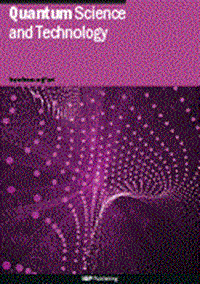具有迁移学习的量子并行信息交换(QPIE)混合网络
IF 5
2区 物理与天体物理
Q1 PHYSICS, MULTIDISCIPLINARY
引用次数: 0
摘要
量子机器学习(QML)已经成为一种创新框架,它有可能通过利用量子系统模拟和利用高维潜在空间的能力来揭示复杂模式,特别是在学习任务中。量子神经网络框架本质上对梯度计算的精度和当前量子硬件的计算限制很敏感,因为幺正旋转带来了复数计算的开销,量子门运算速度仍然是实际实现的瓶颈。在本研究中,我们引入了一种量子并行信息交换混合网络,这是一种新的非顺序混合经典量子模型架构,通过将经典神经网络的预训练参数输入量子电路来利用量子迁移学习。利用非clifford参数化量子门实现了高效的模式识别和时间序列数据预测,从而提高了学习效率和表征能力。此外,我们开发了一种动态梯度选择方法,将参数移位规则应用于量子处理单元(qpu),并将伴随微分应用于图形处理单元(gpu)。我们的研究结果表明,该模型在临时基准测试中表现出更高的准确性,在100步内对额外随机时间序列数据的收敛率降低了约88%,并且在CPU/GPU和IonQ QPU模拟器上显示出更无偏的Fisher信息矩阵特征值谱。本文章由计算机程序翻译,如有差异,请以英文原文为准。
Quantum parallel information exchange (QPIE) hybrid network with transfer learning
Quantum machine learning (QML) has emerged as an innovative framework that has the potential to uncover complex patterns by leveraging the ability of quantum systems to simulate and exploit high-dimensional latent spaces, particularly in learning tasks. Quantum neural network frameworks are inherently sensitive to the precision of gradient calculations and the computational limitations of current quantum hardware, as unitary rotations introduce overhead from complex number computations, and quantum gate operation speed remains a bottleneck for practical implementations. In this study, we introduce a quantum parallel information exchange hybrid network, a new non-sequential hybrid classical quantum model architecture that leverages quantum transfer learning by feeding pre-trained parameters from classical neural networks into quantum circuits. This enables efficient pattern recognition and temporal series data prediction by utilizing non-Clifford parameterized quantum gates, thereby enhancing both learning efficiency and representational capacity. Additionally, we developed a dynamic gradient selection method that applies the parameter-shift rule to quantum processing units (QPUs) and adjoint differentiation to graphics processing units (GPUs). Our results demonstrate that the model performance exhibits higher accuracy in ad-hoc benchmarks, lowering approximately 88% convergence rate for extra stochasticity time-series data within 100 -steps, and showing a more unbiased eigenvalue spectrum of the Fisher information matrix on the CPU/GPU and IonQ QPU simulators.
求助全文
通过发布文献求助,成功后即可免费获取论文全文。
去求助
来源期刊

Quantum Science and Technology
Materials Science-Materials Science (miscellaneous)
CiteScore
11.20
自引率
3.00%
发文量
133
期刊介绍:
Driven by advances in technology and experimental capability, the last decade has seen the emergence of quantum technology: a new praxis for controlling the quantum world. It is now possible to engineer complex, multi-component systems that merge the once distinct fields of quantum optics and condensed matter physics.
Quantum Science and Technology is a new multidisciplinary, electronic-only journal, devoted to publishing research of the highest quality and impact covering theoretical and experimental advances in the fundamental science and application of all quantum-enabled technologies.
 求助内容:
求助内容: 应助结果提醒方式:
应助结果提醒方式:


